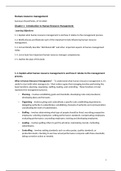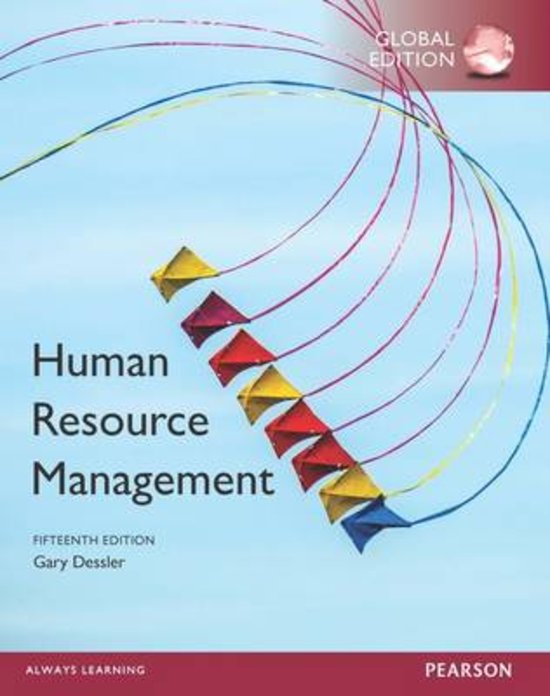Human resource management
Summary PowerPoints, 27-01-2020
Chapter 1 - Introduction to Human Resource Management
Learning Objectives
1-1. Explain what human resource management is and how it relates to the management process.
1-2. Briefly discuss and illustrate each of the important trends influencing human resource
management.
1-3. List and briefly describe “distributed HR” and other important aspects of human management
today.
1-4. List at least four important human resource manager competencies.
1-5. Outline the plan of this book.
1-1. Explain what human resource management is and how it relates to the management
process.
What Is Human Resource Management? – To understand what human resource management is, it’s
useful to start with what managers do. Most writers agree that managing involves performing five
basic functions: planning, organizing, staffing, leading, and controlling. These functions in total
represent the management process.
• Planning – involves establishing goals and standards; developing rules and procedures;
developing plans and forecasts.
• Organizing – involves giving each subordinate a specific task; establishing departments;
delegating authority to subordinates; establishing channels of authority and communication;
coordinating the work of subordinates.
• Staffing – involves determining what type of people should be hired; recruiting prospective
employees; selecting employees; setting performance standards; compensating employees;
evaluating performance; counseling employees; training and developing employees.
• Leading – involves getting others to get the job done; maintaining morale, motivating
subordinates.
• Controlling – involves setting standards such as sales quotas, quality standards, or
production levels; checking to see how actual performance compares with these standards;
taking corrective action as needed.
1
,The topics we’ll discuss should therefore provide you with the concepts and techniques every
manager needs to perform the “people” or personnel aspects of management.
These concepts and techniques include the following:
1. Conducting job analyses (determining the nature of each employee’s job).
2. Planning labor needs and recruiting job candidates.
3. Selecting job candidates.
4. Orienting and training new employees.
5. Managing wages and salaries (compensating employees).
6. Providing incentives and benefits.
7. Appraising performance.
8. Communicating (interviewing, counseling, disciplining).
9. Training employees and developing managers.
10. Building employee relations and engagement.
In addition, what a manager should know about:
1. Equal opportunity and affirmative action.
2. Employee health and safety.
3. Handling grievances and labor relations.
Why Is HR Management Important to All Managers?
1. To Avoid Personnel Mistakes – managers don’t want to make personnel mistakes, such as
not having employees doing their best, hiring the wrong person for the job, experiencing
high turnover, having to be in court due to discriminatory actions, being cited for unsafe
practices, letting a lack of training undermined department effectiveness, or committing any
unfair labor practices.
2. 2. To Improving Profits and Performance – to help ensure that you get results—through
people.
3. You May Spend Some Time as an HR Manager – about a third of large U.S. businesses
surveyed has appointed non-HR managers to be their top human resource executives.
4. 4. HR for Small Business – you may well end up as your own human resource manager.
More than half of the people working in the United States work for small firms. Small
businesses as a group also account for most of the 600,000 or so new businesses created
every year
2
, Line and Staff Aspects of Human Resource Management
Authority is the right to make decisions, to direct the work of others, and to give orders. Managers
usually distinguish between line authority and staff authority.
Line authority gives you the right to issue orders.
Line managers do have many human resource duties. This is because the direct handling of people
has always been part of every line manager’s duties, from president down to first-line supervisors.
Some line supervisors’ responsibilities for effective human resource management fall under these
general headings:
1. Placing the right person in the right job.
2. Starting new employees in the organization (orientation).
3. Training employees for jobs that are new to them.
4. Improving the job performance of each person.
5. Gaining creative cooperation and developing smooth working relationships.
6. Interpreting the company’s policies and procedures.
7. Controlling labor costs.
8. Developing the abilities of each person.
9. Creating and maintaining departmental morale.
10. Protecting employees’ health and physical conditions.
Staff authority gives you the right to advise others in the organization
New approaches to organizing HR
Many employers are changing how they organize their human resource functions.
For example, one survey found that 44% of the large firms surveyed planned to change how they
organize and deliver HR services
• Most plan to use technology to institute more “shared services” (or “transactional”)
arrangements. These establish centralized HR units whose employees are shared by all the
companies’ departments to obtain advice on matters such as discipline problems.
• You may also find specialized corporate HR teams within a company. These assist top
management in top-level issues such as developing the personnel aspects of the company’s
long-term strategic plan.
• Embedded HR teams is another approach that has HR generalists (also known as
“relationship managers” or “HR business partners”) assigned to functional departments like
sales and production. They provide the selection and other assistance the departments
need.
• In addition, Centers of expertise are basically specialized HR consulting firms within the
company.
3






